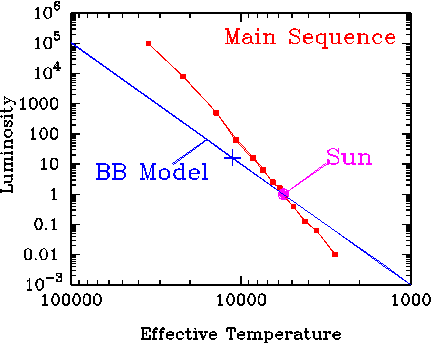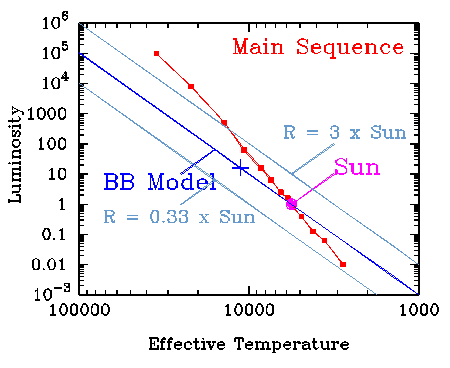



One of the most conspicuous features of a Hertzsprung-Russell (H-R) diagram for any group of stars is the diagonal band running from upper left to lower right where nearly all of the stars are located. This band is called the Main Sequence, and because it's so prominent for any group of stars, it must be important and worthy of further study.
The existence of a Main Sequence in an H-R Diagram indicates that for most stars, there is a correlation between luminosity and temperature. Recall that the x-axis on the H-R Diagram is Temperature and that it's plotted backwards, and that the y-axis on the H-R Diagram is Luminosity, plotted the right way. A correlation is evident because the stars aren't distributed randomly on the plot, but rather in a well-confined region. The plot below shows the Main Sequence as a single line rather than a collection of points. I've done this by calculating the average luminosity for the collection of stars at each temperature, and then plotting only one point to represent all of these stars. Mostly, it makes the plot a bit easier to read.

Note that the correlation between temperature and luminosity is a direct one --- that is, as the temperature increases (i.e., as you go leftward on the plot), the luminosity increases. This direct correlation is somewhat reminiscent of the relationship we learned between the temperature and luminosity of a blackbody emitter. Recall that for a blackbody, the total intensity and temperature are related as follows:
where I is the intensity, and T is the temperature. Furthermore recall that the power, or equivalently, the luminosity emitted by a blackbody is:
where S is the surface area of the emitter. For a sphere (all stars are spherical):
where R is the radius of the sphere. Now, combining these three relations, we get:
= 4 pi sigma R2 T4
and we find that for a blackbody emitter, there is a direct relationship between the temperature and the luminosity. Could this relationship explain the direct correlation between temperature and luminosity seen in the H-R Diagram? It seems pretty plausible, since for a lot of reasons we think that stars emit mostly like blackbodies.
Let's find out. The way to do this is to create a model of how a star would emit if it behaved exactly like a blackbody. The simplest model is to assume that all stars are the size of the Sun, since the Sun is the one star whose size we know. Then our model gives us a direct relationship between the temperature and the luminosity as follows:
= 4 x 3.14 x 5.67 x 10-8 x (6.96 x 108)2 T4
= 3.45 x 1011 T4
We can plot this relationship directly onto the H-R Diagram by calculating the luminosity we'd get for a bunch of different temperature model stars. This will give us a line on the H-R Diagram.

If our model line and the Main Sequence were one and the same, we could conclude that our model "fits" the data, and that our simple blackbody model explains the correlation between temperature and luminosity in real stars. However, these two lines don't overlap, and so we can't claim to have explained the correlation.
In fact, our model does a pretty lousy job of predicting the luminosity of Main Sequence stars based on their temperature. For example, when we plug 11220 K for a temperature into the model, we get out a luminosity of about 14 times the luminosity of the Sun, or 14 Lo (as indicated by the blue plus in the above figure). However, real stars with surface temperatures of 11220 K have luminosities of nearly 100 Lo, or about a factor of five or so higher. Therefore, we have a lot more work to do before we can claim a fit.
Even though the model doesn't fit very well, we would still like to keep some parts of it because they make sense. The first and perhaps most important is that stars behave like blackbodies. There are a lot of reasons we believe this to be so, including the fact that the broadband spectra of stars have the characteristic blackbody shape, and that the temperatures derived from spectral line observations agree with the temperatures derived from fitting the broadband spectrum with e blackbody curve. So, it's worthwhile to try to keep the blackbody assumption if at all possible.
However, we've made another assumption in our model which is almost completely unjustified. We just chose a size for all stars based on our knowledge of the size of the Sun. While this is probably a good starting point, since the Sun is the only stellar object for which we can measure a size, there's no reason all stars have to have the same size as the Sun. What if there exist stars whose sizes are three times larger than that of the Sun? What kind of temperature-luminosity relation might those stars have?
Well, for a given temperature, a larger star will have a larger luminosity. Why? Because while the temperature determines the intensity of the surface of the star, the larger star will have more surface area and therefore will radiate more luminosity, even if the temperatures and therefore the intensities of the two stars are the same (you had a question on this in Problem Set #2; now you know why). So we might expect that the blackbody model for larger stars might appear higher on the H-R Diagram than the line for Sun-sized stars. Likewise, the blackbody model for stars smaller than the Sun would appear lower on the H-R Diagram, since smaller stars have less surface area for radiating.
And that's exactly what you get:

All three model curves have the same slope, and this slope is not the slope of the Main Sequence, so individually, none of these models is going to fit the Main Sequence. This says that stars on the Main Sequence aren't all of the same size, which when you think about it is just fine. After all, why should all stars be the same size anyway?
Although these models individually don't match the Main Sequence, together they span much of the Main Sequence. That is, as long as you don't mind using different star sizes for different parts of the Main Sequence, we can explain all of the stars with a blackbody model where the temperature and star size increase together. Low temperature Main Sequence stars can be best explained by our blackbody model if their sizes are also smaller than the Sun, and high temperature Main Sequence stars can be best explained if their sizes are also larger than the Sun.
Thus we can explain the apparent correlation between temperature and luminosity in the HR Diagram in terms of a blackbody model and another correlation -- the correlation between temperature and size -- for Main Sequence stars. In addition, we can also see that position on the H-R Diagram can tell us the size of the star; stars in the upper right are much larger than the Sun, and stars in the lower left are much smaller than the Sun. The stars of the Main Sequence fall in a relatively narrow range of sizes, with radii ranging from about 30% of the Sun's radius to about 10 times the Sun's radius.
We'll see in later sections of the course that this new correlation between surface temperature and star size is a result of yet another more fundamental parameter --- the star's mass.
Back to the Astronomy 102 Specials Page
This page is maintained by Ned Ladd, ladd@bucknell.edu
